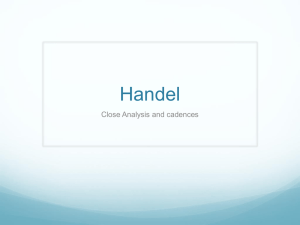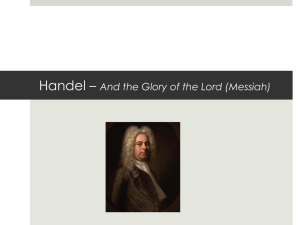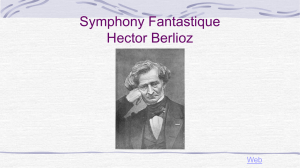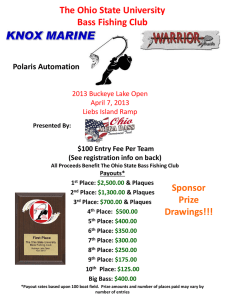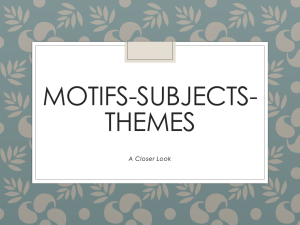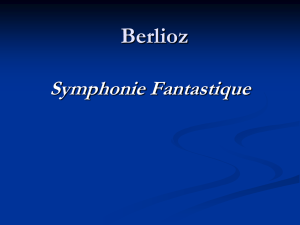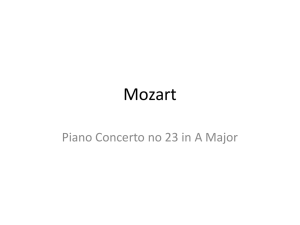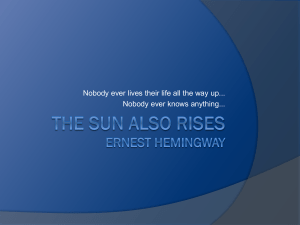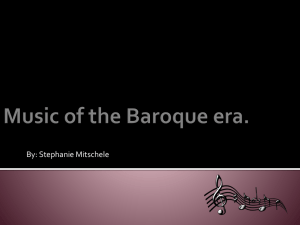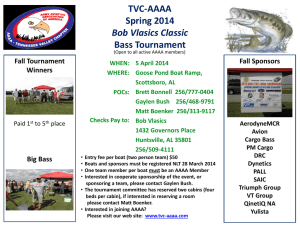bass - St Peters Music Department
advertisement
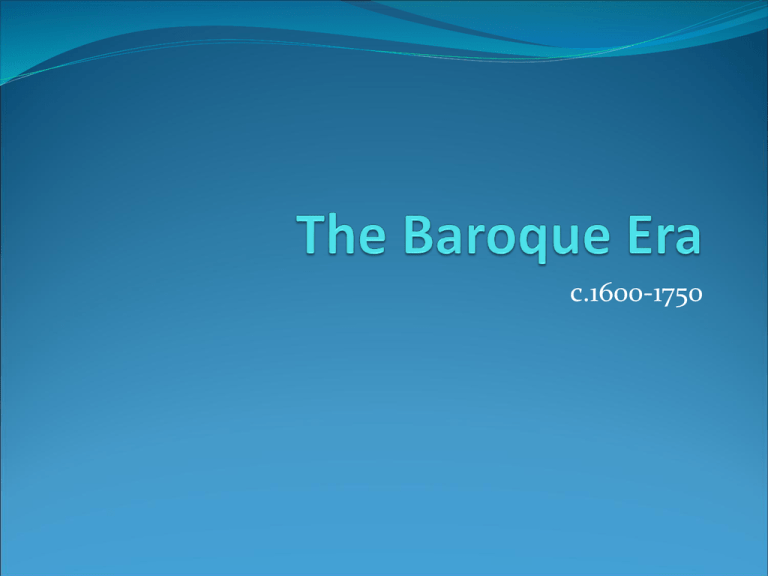
c.1600-1750 Portuguese for Pearl… Referring to the ornate architecture, art, melodies. This period saw many new ideas and innovations Characteristics of Baroque Music Unity of Mood: a piece usually expresses one mood or affection Rhythm: patterns are repeated through out the beat is emphasized Melody: repeated, ornamented Use of Diatonic chords of I,IV,V,II,VI Characteristics of Baroque Music continued Terraced Dynamics: alternation between loud and soft dynamics organ and harpsichord could not crescendo Musical textures Monophonic Homophonic Polyphonic Ornaments Trill Turn Mordent Acciaccatura/Appoggiatura Grace note Basso Continuo Common type of accompaniment Bass line with improvised chords cello or bassoon on bass harpsichord or organ on harmony Basso continuo The Baroque Orchestra small (10 to 40 players) basso continuo and violin family strings brass, woodwinds and percussion used occasionally, but vary from piece to piece. tone color was subordinate to the melody, rhythm or harmony Music in Baroque Society Music written to order: demand for new music. Main source of diversion in the courts of the aristocracy. Music Director’s job Pay and prestige were high compositions were performed Still a servant of the patron Music in Baroque Society Church musicians earned less than the court and lower status supplemented with weddings and funerals Town musicians Opera houses Important composers Johann Sebastian Bach (1685-1750) George Frederick Handel (1685-1759) Henry Purcell (c.1659-1695) Antonio Vivaldi (1678-1741) George Friderick Handel George Frideric Handel b. Halle, Germany (one month before Bach) in 1685 Devoted his life to music from age 18 First Opera –Rodrigo- was performed in 1710 Appointed Kapellmeister to Elector Georg Ludwig of Hanover (Later becoming George I of England) Promoted with George I to Royal Composer Handel in London Favorite of Queen Anne Wrote ‘Water Music’ in 1717 English Oratorios after failure of Italian Opera Blind - from cataracts Died in 1759 and Buried in Westminster Abbey Handel - Music Instrumental suites organ concerti concerti grossi Vocal Music 39 Italian operas Oratorios (mostly in English) The Oratorio a large-scale composition for chorus, vocal soloists, and orchestra uses choruses, arias, duets, recitatives, and orchestral interludes chorus acts as commentary last approximately 2 hours The Oratorio Set to a narrative text No acting or scenery Based on the Bible Originally performed in prayer halls called oratorios Handel - Oratorios generally Old Testament for the paying public, not church have plots, but no scenery or acting chorus is the focus Listening: Messiah lasts 2 1/2 hours composed in 24 days Premiered in Dublin, Ireland in 1742 as a benefit for people in debtor's prison later tradition as London orphanage benefit concert Only one to use New Testament verses Messiah - Three Acts Part 1 Prophesies telling of the coming of Christ His Birth Easter Part 2 The Passion of Christ Set mainly to words from the Old Testament Pentecost Part 3 The Resurrection Pentecost Part 3 The Resurrection Structure of an Oratorio Recitative Aria Chorus And the Glory of the Lord Idea 1 And the Glory of the Lord Idea 2 And the glory of the Lord Idea 3 And the glory of the Lord Idea 4 The whole movement is in A major Modulates to the dominant (Emaj) and the Dominant – Dominant (Bmaj) No minor keys to kepp one ‘affection’ Introduction Lively ¾ - Feels like one-in-a-bar Orchestral introduction Hemiola at the end of the introduction Descending sequences (bars 5-6 and 7-8) Instruments double voice parts throughout Analysis: Bar 1-11 Orchestral introduction States ideas 1 and 2 Example of descending sequence (bar 5-6 and 7-8) Hemiola rhythm in bar 9-10. Very common as a cadence approach in Baroque music Ends with a perfect cadence, (V-I) Orchestra always doubles the voices Music is driven by the regular on-beat crotchet rhythms (look at the bass part) Analysis: Bar 11-14 Alto entry with motif 1 mf = Mezzo Forte (Quite loud) Syllabic setting of the text Perfect cadence in bar 13-14 Analysis: Bar 14-17 f chordal respone by soprano, tenor and bass Homophonic texture The bass often has the melody if the texture is homophonic Perfect cadence in bar 16-17 (Vb-I) Analysis: Bars 17-22 Imitative entries of motif 2, by tenor, bass, then soprano. Built up on the 2 one-bar descending sequence on ‘revealed’ Modulating from A major to E major, using the chords Vb-I Analysis: Bar 22-33 In E major, the dominant key First time that motif 1 and 2 are combined Tenor and Soprano have motif 1 (an octave apart) Alto and bass have motif 2 The result = 2 part counterpoint (tune vs tune) Contrast of texture is created so we have variety, keeping the listener interested. It is a major feature of the whole movement! Bass and tenor = low (bars 22-25) Soprano and alto = high (bars 25-28) Alto and tenor = middle (bars 28-31) Analysis: Bar 33-38 Strong, 4-part homophonic texture of motif 1 in E major Melody is in the bass with ‘shall be revealed’ tagged onto the end Analysis: Bar 38-43 Orchestral link using motif 2 Use of sequences (bar 38-39) Use of hemiola rhythms (bar 41-42) Use of a suspension (bar 42) These features are all found in the introduction Analysis: Bars 43-50 Alto makes the first statement of motif 3. Tenor follows in bar47-50. Contrast in texture – Thin with one line at a time contrasting with the 4-part homophonic sections. Modulate back to A major (tonic/I) Note strong crotchet bass line (E-C#-A) A major is confirmed by a perfect cadence in bars 4647 Analysis: Bars 51-57 Tenor and bass introduce motif 4. Adds weight and gravitas to the statement by being low and dotted minims. Repeated notes in the motif act as a pedal (in this case a tonic pedal) This 2-part texture becomes a 4-part texture in bars 53-57 with sopranos and altos singing motif 3 (in sixths) Perfect cadence ends the section (V7c-I) Suspension in bar 56 (7-6 suspension between alto and bass) Analysis: Bars 58-73 Sopranos sing motif 4 on a dominant pedal (an inverted pedal at the top of the texture) Alto, tenor, bass sing motif 3 and ends with a plagal cadence. (IV-I) Imitative entries in these parts as we modulate to E major. Bar 68-73 = Tenor/Bass on motif 4 and soprano/alto with idea 3 one bar later. Ends with a perfect cadence in B major (Dominant-Dominant) Bars 74-83 Short orchestral link based on motif 1 Leads to 4-part homophonic rendition of motif 1 in B major Note original melody is in the bass. This then leads to motif 3, arranged in a new texture. All parts return for a homophonic ‘Together’ on chord I-V (imperfect cadence). Momentum is carried on immediately by the sopranos. Bar 83-102 Dovetails with last section with sopranos singing motif 4 on an F# - NB every time we hear this motif it is higher in pitch. (A-E-F#). Over the next dozen bars, all 4 motifs come together Bar 84 = Altos sing motifs 1 and 2 Decending pitch as alto-tenor-bass sing short melodies Bar 89-92 – Motif 3 is shortened by one bar Breakdown of texture is short lived as Handel brings in all voices at 93-94. Bar 83-102 continued... Bars 93-102: Handel uses motif 1, 2 and 4 in different parts. Music modulates back to E major in this section. This section ends with a perfect cadence in E major (VI) Modulate straight away back to A major (Tonic key) Bars 102-124 Altos sing motif 3, fragmented to one bar echoes in the tenor and bass. This reduces the texture to a minimum beofre the final section. Parts added quickly in bars 105/6, reaffirming words ‘see it together’. Climax of movement = Sopranos singing motif 1 ending on a top A This is answered by the other 3 parts, with the tune in the bass. Bars 102-124 Imitative entries follow Bar 118 = Alto, Bar 119 = soprano and tenor = motif 3 This is underpinned by basses singing motif 4 on a E (Dominant pedal). Section ends on an imperfect cadence (I-V) at bars 123124. Bars 124-134 Sopranos begin the final section by taking over idea 4 from the basses. All other parts answer with motif 4 Firmly stated on the tonic, A. Bar 129-134 is heard at 51-55. This time soprano/altos and tenor/bass have swapped parts = Invertible Counterpoint. 3 parts start with motif 4 before coming to a dramatic halt at bar 133 (Handel does this quite often at the end of a chorus e.g Hallelujah Chorus) Bars 134-138 A dramatic 3 beat rest in all voices and instruments Tempo changes to Adagio for the final plagal cadence in A major. In 4-part homophony adding emphasis to the final words ‘Hath Spoken it’. Summary of choral styles used Choral Style Example Monophonic writing (Single line) Bars 11-13 Homophonic writing (4-part choir) Bars 33-38 Simple imitation Bars 17 onwards 2 part counterpoint (Tune v Tune) Bars 110-113 Doubling of parts Bars 51 onwards ‘for the mouth’ Key words (The bare minimum – You can, and must, add to this!) Cadence Pedal Harmonic rhythm Perfect cadence Hemiola Plagal cadence Homophonic Imperfect cadence Monophonic Pitch Polyphonic Tonic Counterpoint Chord Vb Imitative Chord V7 Modulation Mellisma Syllabic Section A Questions 1. 2. 3. 4. 5. 6. 7. 8. 9. How is the joyful mood/affection achieved in this piece (1) Name 3 textures used in this piece (3) Name the 4 voice parts used in this piece (4) What instruments accompany the singers (4) How many melodies (motifs) are used in the chorus? (1) Identify 2 ways in which the last 3 bars are dramatic (2) Give bar numbers where you can hear the following 1. One voice part 2. 2 voice part 3. 3 voice part 4. All 4 voices together (4) In general, how are the words set to the music? (1) How is the word ‘revealed’ treated throughout the piece? (1) Section B Question a) In which year did Handel write the Messiah? (1) b) Which type of vocal work is the Chorus taken from? (1) c) Describe this set work using the following headings I. II. III. IV. V. Form/Type of Composition Melody Texture Dynamics Rhythm (10 Marks)

